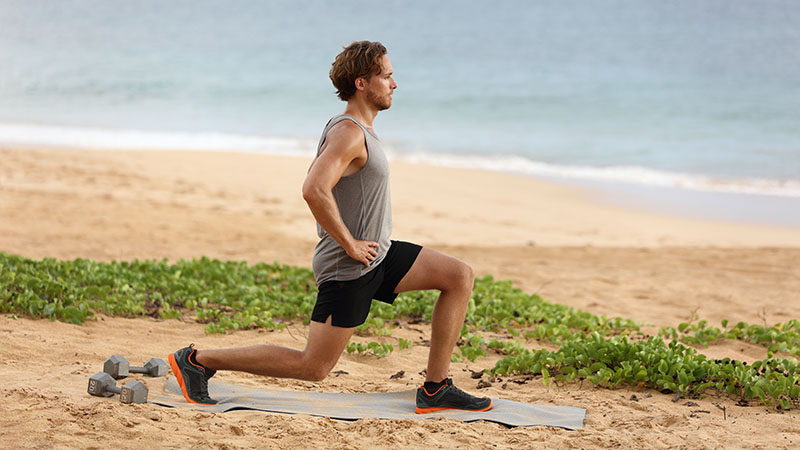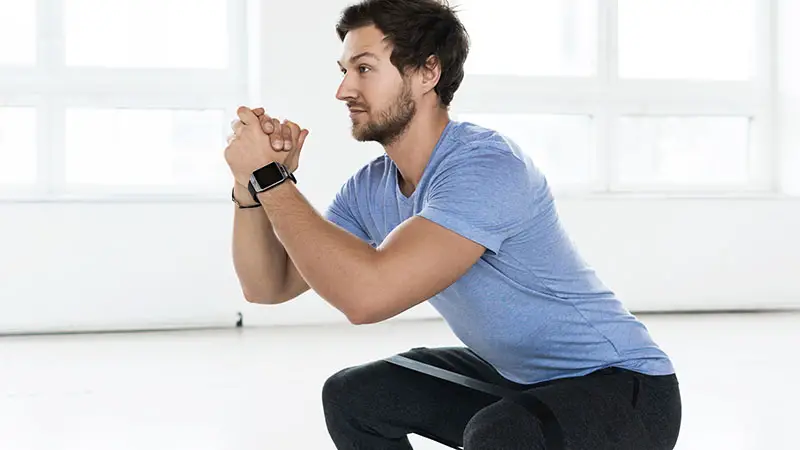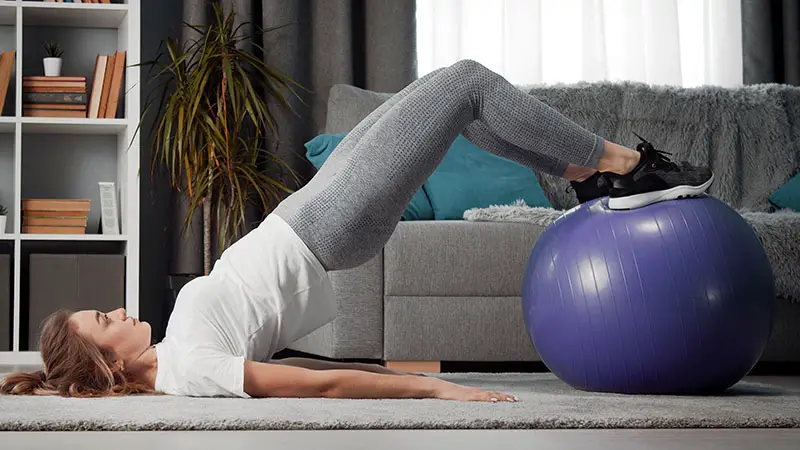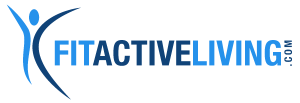Contents
Glute bridges are one of the biggest go-to exercises to strengthen your glutes and hamstrings. If it’s a leg day, there’s a pretty high chance that this exercise will be in your workout. They’re low impact, and they don’t require any fancy equipment, but still incredibly effective!
However, no matter how much you love this workout, if you do it too much, you risk plateauing. Or maybe you’re simply bored with doing this exercise so frequently. Either way, it’s important to change up your workouts to keep your muscles guessing. Thankfully, there are a wide variety of alternatives to this amazing workout! There are dozens of glute bridge alternatives that target similar muscle groups and will change things up!
Glute Bridge Alternatives
1. Squats
Squats are one of the most popular exercises. Arguably, they may be more popular than glute bridges, but many don’t realize that they’re a great glute bridge alternative that doesn’t require any equipment!
Steps
- Stand with your feet slightly wider than hip-width apart.
- Engage your core and find a focal point straight ahead of you.
- Keep your gaze forward as you lower your hips, bending your legs until they are almost parallel to the ground.
- Exhale as you come back up to standing position, tightening your glute muscles as you stand.
Muscles Worked
When doing squats, you are working your glutes, quads, hamstrings, adductor, and core.
Benefits
Just with the glute bridges, squats bring a great number of benefits. They work to strengthen your core while focusing mainly on your legs. While form is essential, when done correctly, this glute bridge alternative can actually help prevent injury, which is another wonderful benefit. Last, the biggest benefit to incorporating squats into your workout routine is their versatility. Not only can we do them anywhere, but there are so many varieties that you will probably never get bored. You could hold a squat challenge with friends, you can do them while you’re brushing your teeth, or you can do them traditionally in a workout, and that’s why they are such a great glute bridge alternative.
Exercise Tips
Form is everything when doing squats. Some may have heard that people who do squats are prone to injury, but the opposite is actually true. The people who become injured from squats are more often than not lacking proper form. So, the biggest tip for doing squats is to make sure you are doing them correctly. Read the above steps or have a certified personal trainer teach you.
2. Lunges

Lunges are another great, no equipment required glute bridge alternative. Like squats, you may not think of lunges like glute bridges, but when you take a good look, they target a lot of the same muscles and you can do them from anywhere.
Steps
- Start with legs hip width apart and hands on your hips
- Step forward with your dominant leg
- Bend both your knees at 90-degree angles, making sure that your front leg’s knee is not going over the ankle
- Lift yourself up, bringing yourself to a standing position and then bring your dominant leg back to the starting, hip-width apart position
- Repeat these steps for your non-dominant leg
Muscles Worked
Because you are alternating legs, lunges require you to work on stability. This exercise inadvertently targets your core muscles along with the lower body muscles, including glutes, hamstrings, quads, and calves.
Benefits
As mentioned above, this exercise engages your core because you are balancing, thus a big (positive) side effect of doing lunges is that you will more than likely see an improvement in your balance.
Because of the bilateral nature of this exercise, you may also feel or see improvement in your symmetry and alignment besides the expected benefit of building strength in your lower body.
Last, similar to squats, the biggest benefit of incorporating lunges into your workout regime as a glute bridge alternative is that they require no equipment and you can do them anywhere.
Exercise Tips
If done incorrectly, lunges can trigger some people with a history of knee discomfort or pain. To prevent this, be sure to monitor your comfort level while also making sure that your front knee does not go beyond your ankle. Another tip I have for those with a history of knee pain or previous injuries, aside from consulting with your doctor first, is to place a towel down for the knee getting close to or touching the ground. Or, at the very least, use a workout or yoga mat if your knee is going to touch the ground during this exercise.
3. Donkey Kicks
Another great glute bridge alternative is the donkey kick. It’s relatively easy to do and doesn’t require any equipment, like the alternatives mentioned above, and it still focuses on the key muscle groups that benefit from glute bridges.
Steps
- Start on all fours with your arms and knees shoulder-width apart
- With your core tightened, flex your dominant foot and lift your leg up (kicking it into the air), keeping your knee bent at a 90-degree angle.
- Be sure to exhale as your leg goes up, and inhale as you bring it back to the all fours position.
- Repeat these steps for a predetermined amount of time before switching to the other leg.
Muscles Worked
The focus of this bilateral movement is on the glutes and the hamstrings. You will also work your core and lower back muscles to maintain balance and support while lifting and lowering your legs.
Benefits
The major benefits of incorporating donkey kicks into your workout regimen are the ability to build strength in your lower body, work bilaterally, and increase your balance and mobility. Another unexpected benefit for this exercise is that it can help with your posture! Your lower back muscles are an integral part in maintaining good posture, so by strengthening those muscles, you could see an improvement in your posture!
Exercise Tips
To prevent injury, it’s advised that you make sure that you never lift your thigh higher than your torso when kicking. This could add strain to your lower back. Ideally, you want to lift your thigh to be parallel to the floor and in line with the rest of your body.
The best tip to make sure you’re getting the most out of this exercise is to make sure your core is engaged throughout. By having your core tight, you are more stable and be able to execute the move more effectively.
4. Fire Hydrant

Similar to the donkey kicks, the fire hydrant is an exercise executed on all fours that targets many of the muscles used in glute bridges. The big difference, however, is how you are moving and activating your lower body and leg muscles. If you enjoy glute bridges, but want to give something different a try, you should definitely add fire hydrants to your list!
Steps
- Start on all fours with your knees directly under your hips and your hands directly under your shoulders
- Flex your dominant foot, engaging your leg muscles as you lift your leg away from your body at a 45-degree angle while keeping your knees bent at a 90-degree angle
- With control, lower your leg back down to the starting position
- Repeat this movement for the determined number of times before switching to the other side
Muscles Worked
While fire hydrants may not target your hamstrings as much as glute bridges, they make up for it with their special attention to all the different and hard to reach areas of your glutes. This exercise also works your hip abductors and your core.
Benefits
This glute bridge alternatives biggest benefit is in rotational movement. Because of this, you are not just strengthening your lower body, but you are working on hip rotation, extension, and improving your mobility while also strengthening your lower back and core.
Exercise Tips
When doing a fire hydrant, you want to make sure that you prevent hyperextension. The best way to do this is by bringing in your knees a little when you are on all fours, making sure they are a little more narrow than hip width apart.
5. Clamshells
Continuing with the trend of funny exercise names, we have the clamshells. They are an excellent glute bridge alternative that is probably the lowest impact on this list.
Steps
- Lay down sideways with your hips stacked, knees bent at a 45-degree angle, and shoulders stacked
- Keeping your hips stable, rotate your top knee open (mimicking an open clamshell) facing the ceiling.
- Return your leg back to starting position.
- Repeat for the desired amount of times before flipping over for the other side.
Muscles Worked
When researching the muscles worked with this exercise, I found it to be incredibly similar to fire hydrants. The rotation work targets your glute medius muscles (the smaller glute muscles) and hips in a way that isn’t found in many other exercises while also working your core and lower back.
Benefits
Like many others on this list, you don’t need any equipment, which is a tremendous benefit. Another benefit is that it’s incredibly low impact as you’re laying on the ground while doing it. But, the best thing about clamshells is that they strengthen your lower body while also being one of the best exercises for hip strengthening.
Exercise Tips
While keeping your hand on your hip might look cool, it actually serves an important purpose. Keeping your hand on your hip brings more stability and helps you to keep from wiggling too much, allowing you to get more results from this exercise.
6. Banded Squats

If you’re looking to level up your exercises, you can always try variations or add equipment to get even more benefits. For example, instead of simply doing traditional squats as a glute bridge alternative, you could give banded squats a try!
Steps
- Grab a loop band and place it just below your knees.
- Stand with your feet slightly wider than hip width apart and make sure that the band is tight.
- Place your hands out in front of your body
- Squat down while engaging your core and keeping your knees strong, preventing them from buckling inward
- Come back to the standing position
Muscles Worked
Because banded squats are still squats, they also work your glutes, quads, hamstrings, adductors, and core as mentioned above.
Benefits
There’s a long list of benefits to using banded squats as a glute bridge alternative. One of the biggest benefits that sets it apart from a traditional squat is that it allows you to customize this exercise. There are loop bands in all sizes and resistances, so you can challenge yourself as much as you need. Instead of simply needing to add more reps, you can add resistance (weight) and see amazing results. Another incredible benefit of doing banded squats is that you can work on your weaknesses. For many people, their knees can buckle inward while squatting. With the bands, it has you specifically working on keeping your knees apart, adding more tension and strengthening this area even more.
Exercise Tips
When using bands and other equipment in your workouts, start small. You can always go up as you gain confidence, but your form is of the utmost importance. If you notice you cannot keep your knees stable when performing this exercise, either lighten the resistance by choosing a different band or do the squat at a slower pace.
7. Banded Clamshells
Just with banded squats, banded clamshells are essentially the same as above, but with a little more oomph!
Steps
- Lay down sideways with your hips stacked, knees bent at a 45-degree angle, and shoulders stacked
- Place your loop band around your legs, placing them on your thighs slightly above your knees
- Keeping your hips stable, rotate your top knee open, facing the ceiling
- Return your leg back to starting position
- Repeat for the desired amount of times before flipping over for the other side
Muscles Worked
As with traditional clamshells, banded clamshells work the same muscles: glutes, hip abductors, lower back muscles, and core.
Benefits
With the band, you’re going to see more strengthening benefits because of the added resistance. Adding a band is a tremendous benefit because you can customize your workout with all the different band sizes and resistances!
Exercise Tips
Listen to your body (and doctor) if you are using any type of workout equipment! Because you are using a resistance band, you could easily over-strain your muscles, so make sure that you are careful and start with a smaller weight, working your resistance up.
8. Hip Lifts on an Exercise Ball

For our final easily implementable glute bridge alternative, we have hip lifts while using an exercise ball. If you have an exercise ball lying around the house or have access to one in your local gym, you won’t regret giving this exercise a shot!
Steps
- Grab your exercise ball
- Lay on the ground with the exercise ball between your legs
- Bring your heels onto the exercise ball
- Press through the heels to raise your lower body off the ground, keeping your shoulders and head planted firmly
- Slowly, with control, lower your body back down to the ground and repeat
Muscles Worked
Because of the exercise ball, your core is going to be working more than in any other workout on our list. But, it’s important to remember that this exercise will also target your glutes, hamstrings and quads.
Benefits
There are so many benefits in this workout! As mentioned above, the exercise ball incorporates more instability than you would typically get from a traditional exercise, meaning that your body has to work even harder to stabilize. Thus, you will increase your stability.
Exercise Tips
Take your time and focus on your muscles with this exercise! It’s not about all about speed in getting the best results!
9. Reverse Hyperextension
This exercise works your glutes, hamstrings and lower back. It is a great exercise that can help to reduce lower back pain.
Steps
- Lay your upper body on a bench or bed while letting your legs and hips hang off.
- With your legs straightened behind you, contract your glutes and slowly raise your legs and hips until they are parallel to the floor. You should feel the contraction in your glutes, hamstrings and lower back.
- Slowly touch your feet to the ground and repeat.
- Repeat 10-15 times.
Muscles Worked
Glutes, hamstrings, lower back
Benefits
This exercise has numerous benefits. People who have lower back pain and begin performing this exercise, will in many cases cure their back pain. This is because the the glute muscles are the foundation of the lower back. If your glutes are weak, your lower back muscles will try to take up their slack. This exercise can be done anywhere – on a bench, on a bed or on table.
Exercise Tips
As you gain strength, you can begin to increase the amount of time you hold the contraction at the top of the exercise. Rotate your legs out at the top of the exercise for an extra glute contraction.
10. Hip Thrust

The hip thrust is a great resistance exercise for building strength in your glutes.
Steps
- First, you might want to try the exercise without weights first to establish your balance and become familiar with the range of motion. From there, you may want to use just the bar without plates so you can practice getting into and out of the position. You may also want to wrap a pad or towel around the bar to protect your hip bones.
- Set up the bench behind you. Begin in a seated position on the floor with your knees bent and feet slightly wider than hip-width apart. Rest your upper back against the edge of the bench in the middle of the bench. Then place the barbell across your hips
- Engage your glutes and press the bar upward until your hips are in line with your knees and shoulders. Keep your chin slightly tucked and your core tight.
- When your hips are fully extended, aim to have a 90-degree bend at the knees.
- Slowly lower your body down until your hips are a few inches off the floor.
- Repeat for 8-10 repetitions.
Muscles Worked
Glutes and hamstrings
Benefits
As a great alternative to squats for working on your glutes, hip thrusts take some of the pressure off of your knees. With stronger gluteal muscles, exercises such as cleans and snatches will become more explosive.
Exercise Tips
Focus on contracting your glutes and holding at full extension for a few seconds each rep to get a good burn. Also, a barbell is not required to perform hip thrusts. You can do them using just your bodyweight or other resistance – such as dumbbells or any other weights you have on hand.
